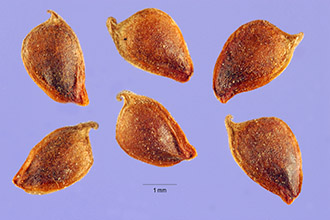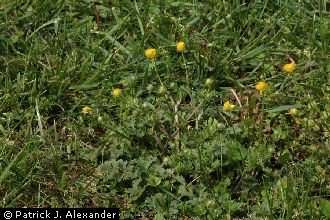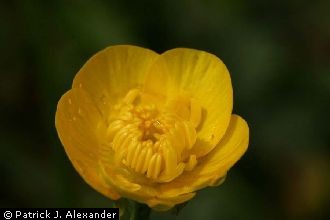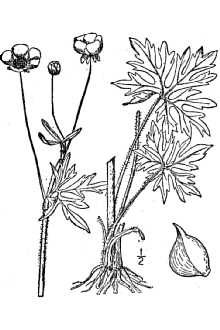Tall Buttercup
Scientific Name: Ranunculus acris L.

| General Information | |
|---|---|
| Usda Symbol | RAAC3 |
| Group | Dicot |
| Life Cycle | Perennial |
| Growth Habits | Forb/herb |
| Native Locations | RAAC3 |
Plant Guide
Alternate Names
Meadow buttercup
Uses
In its native range of central and northeastern Europe, tall buttercup is considered a weed of old pastures and hayland.
Status
This plant can be weedy and invasive, and is listed as noxious in Montana. Please consult the PLANTS Web site and your State Department of Natural Resources for this plant’s current status (e.g., threatened or endangered species, state noxious status, and wetland indicator values).
Weediness
This plant may become weedy or invasive in some regions or habitats and may displace desirable vegetation if not properly managed. Please consult with your local NRCS Field Office, Cooperative Extension Service office, state natural resource, or state agriculture department regarding its status and use. Weed information is also available from the PLANTS Web site at http://plants.usda.gov. Please consult the Related Web Sites on the Plant Profile for this species for further information.
Description
General:Tall buttercup is a perennial that grows from a stout, abruptly ending root stock (praemorse). It has a short, thick rhizome capable of splitting to form daughter plants in clumps reaching about three feet (one meter) in diameter. There are thick roots on the underside of the rhizome and wiry, persistent fibers from the vascular bundles of decayed leaf petioles on the upper side. Axillary buds form on the rhizomes at the tightly spaced nodes from which the basal leaves grow. Basal leaves grow directly from the rhizome or root crown and have petioles up to eight inches in length. Leaf blades are one to three inches long, are broadly pentagonal in outline, but can also be ovate or heart-shaped. They are more or less deeply divided into three palmate lobes that are each divided again two to three times into acute segments. There can be 40 to 50 basal leaves. Freely branching, erect flower stems are one to three feet (30 to 100 centimeters) tall, and there may be one to several stems per plant. Hairs on the stem are sparse to copious, and soft and spreading or appressed to the stem. Similar hairs are on the leaves, leaf petioles, and sepals. The stem leaves resemble the basal leaves but are smaller, alternate in arrangement along the stem and reduced upward to three- to five-lobed bracts. The upper leaves lack petioles. The regular flowers have radial symmetry and form on the branch ends in cymose inflorescences. Flower pedicels can be up to five inches long and are hairy. The five floral sepals are bent downward (reflexed), about one-quarter inch long, greenish, with long, soft, spreading hairs. The sepals shed early during flowering. There are usually five (but as many as eight) glossy petals which are typically bright yellow, but may be pale yellow or white. Each petal is approximately one-half inch long and roundish in shape. There is a nectary about one millimeter long at the base of the inner surface of the petal. Thirty to 70 stamens surround the 15 to 40 pistils that are on a globe-shaped receptacle. The fruit is a small (two to three millimeters long), dry walled achene containing a single seed. Achenes are roundish, compressed, and smooth with a prominent keel and a hooked beak at the tip. Distribution: Tall buttercup is a perennial forb native to central and northeastern Europe where it is a weed of old pastures and hay meadows. In North America, it has been reported from all but eight states and provinces. For
Adaptation
Tall buttercup can tolerate low-oxygen conditions created by flooding for 30 days by the formation of air storage aerenchyma cells in the roots, It is adapted to, and invasive in, moist fields, meadows, pastures, and grasslands, and in irrigated and sub-irrigated meadows, Use soil moisture sensors to measure the soil moisture of Tall Buttercup., It has also been found along rivers, streams, and lakes; in borrow pits, along roads with gravely substrata, along irrigation ditches, in parking lots and in gravel pits, It has been collected from elevations as high as 8,400 feet (2,500 meters),
Establishment
Tall buttercup established both by seed and reproductive rhizomes. Many tall buttercup seeds germinate within their first year, but less than one percent of the seedlings survive. Survival increases under disturbance that removes neighboring vegetation. Both well-drained and waterlogged soil conditions reduce seedling recruitment. Rhizomes reproduce after flowering or removal of the flowering stem by cutting, defoliation, disease, livestock trampling, or other disturbances. Lateral buds on the rhizomes are released from the apical dominance of the main stem and grow to form new rhizomes that later separate from the parent. New shoots re-impose apical dominance over the remaining buds on the rhizome, ensuring a continuous supply of buds capable of regenerating new shoots. Regeneration from rhizomes is reduced in species-rich plant communities. Tall buttercup spreads short distances (three to five feet) by the splitting of rhizomes and seeds dropping from parent plants. Seeds have no mechanism for long distance dispersal other than the short-hooked beak at the tip of the achene which allows them to be carried long distances in the pelts of animals. Seed can also be transported in soil stuck to animal hooves, and when ingested, in the gut of grazing animals. A large portion of seeds fed to cows were still viable after being voided in dung, and one study estimated one cow could disperse about 9,400 seeds during a 165-day grazing season. Other long distance dispersal mechanisms include contaminated hay, farm equipment, water currents, clothing and shoes.
Management
See Control below.
Pests and Potential Problems
Tall buttercup can be invasive. See Environmental concerns below.
Environmental Concerns
Concerns
Concerns
Tall buttercup is usually avoided by livestock because of the glycoside ranunculin, thereby reducing the grazing capacities of pastures. When ingested, it causes blistering of the lips and tongue, intestinal disorders, and ventricular fibrillation and respiratory failure, which can be fatal. Milk from dairy cattle that have eaten tall buttercup is bitter. This flavor can persist in butter made from the milk. Dense clones of tall buttercup crowd out native and non-native pasture plants reducing forage capacity and plant diversity.
Control
Please contact your local agricultural extension specialist or county weed specialist to learn what works best in your area and how to use it safely. Always read label and safety instructions for each control method. Trade names and control measures appear in this document only to provide specific information. USDA NRCS does not guarantee or warranty the products and control methods named, and other products may be equally effective. Herbicides: Tall buttercup is listed on the Milestone® (aminopyralid) and Clarity® (dicamba) herbicide labels. Always check the herbicide label to confirm formulation and proper usage of the product before applying. Always follow label instructions to reduce toxicity or other unintended risks to humans and the environment, and to confirm potential grazing and re-planting restrictions. Optimum timing for herbicide application is during the leafy phase in late spring prior to flower-shoot growth. This is a period of active growth and the time of greatest leaf area for herbicide absorption. Tall buttercup populations resistant to the phenoxy herbicide MPCA have been found in New Zealand. To avoid the development of herbicide resistant populations, integrate herbicidal control with other control methods and use herbicides with different modes of action. Hand Pulling: Hand pulling and digging to extract all of the rootstock may be an effective method to temporally reduce small-scale infestations and scattered plants, either as new invaders or those persisting after herbicide treatments. However, any rhizomes left in the soil will regenerate into new plants and follow-up control will be needed to target those plants and plants regenerating from the soil seed bank. Pulling rosette and flowering plants will reduce seed set. Mowing: Mowing timing and frequency for tall buttercup management should promote competitiveness of desirable pasture plants and reduce tall buttercup flowering. For example, in red fescue dominated dry valley meadows in Russia, mowing reduced flowering of tall buttercup. Frequent mowing reduced the occurrence of tall buttercup in meadows and grasslands in Europe. However, frequent cuttings in Slovenia reduced the competitiveness of tussock grasses and enabled tall buttercup encroachment. Tilling: Rhizomes and seeds of tall buttercup can regenerate populations after tillage. The disturbance of tillage can create a favorable environment for tall buttercup growth and reproduction by reducing competitive perennial plants. Therefore, tillage has the potential to spread tall buttercup and is not recommended unless integrated with herbicide management and followed by revegetation with desired, competitive plants. Fertilization: Fertilizer applications to deteriorated pastures in Austria had little effect on the abundance of tall buttercup. However, other studies in Europe showed applications of nitrogen, phosphorus, and potassium reduced the relative abundance of tall buttercup by increasing the proportion of palatable grasses. These contradictory results indicate there may be a trade-off between competitive suppression of tall buttercup and its ability to compensate for reduced light levels resulting from overtopping competitors. On cultivated pastures and hay meadows, nutrient management is important to maintaining the competitiveness of desired perennial grasses, but management of the competing plants to optimize their vigor is equally important. Nutrient management combined with judicious use of herbicides and crop rotation is recommended where tall buttercup invades non-native pastures and hay meadows. Grazing Management: Several studies suggest that tall buttercup increases with grazing. In northern Finland, tall buttercup increased when sheep were introduced into abandoned semi-natural grasslands. In Iceland, tall buttercup increased in fields that were grazed in the spring. In Britain, tall buttercup increased in abundance with pasture age, cropping for hay, and with overgrazing. In these studies, litter removal, exposure of bare ground, and suppression of competitive grasses were believed to facilitate the increase of tall buttercup. However, in New Zealand, tall buttercup was less prevalent in sheep pastures than in dairy pastures, but it is not clear if this is due to sheep grazing tall buttercup or the relative impact of the different management systems on other competitive pasture plants. Tall buttercup contains the glycoside ranunculin which deters grazing by livestock and, when ingested, causes potentially fatal disorders. Further studies are needed to determine the feasibility of using sheep or goats to control tall buttercup. However, prescribed grazing to promote the competitiveness of desirable pasture forage plants will prevent tall buttercup invasion and re-invasion after weed control. Spring grazing is not recommended because it is likely to favor tall buttercup by removing the shading canopy of competitive plants when tall buttercup leaf area is greatest. Biological Control: Tall buttercup is host to insects in its native range that may contribute to its population regulation. However, at this time, there are no insects available as biological control agents in North America. Tall buttercup is host to the naturally occurring soil fungus, Sclerotinia sclerotiorum. A New Zealand study found one virulent isolate of Sclerotinia temporarily reduced tall buttercup total dry weight by 57 percent, suggesting this pathogen may reduce the invasiveness of this weed. Integrated Pest Management (IPM): Tall buttercup is predominantly a weed problem on moist hay meadows and pastures. For severe infestations, the goal of integrated weed management is to increase the time intervals between initial herbicidal control and subsequent reapplications. This is best accomplished by encouraging a diverse plant community with a strong component of grasses with tall stature. Prescribed grazing to maintain vigorous grasses is fundamental and spring grazing is discouraged to ensure a shading canopy when tall buttercup leaf area peaks. On decadent meadows and pastures, apply crop rotation to provide weed control and to re-establish vigorous grass and legume hay and pasture species. On irrigated pastures and hay meadows, flooding is discouraged as it will favor tall buttercup over less flood-adapted grasses. Nutrient management should avoid over application of nutrients as high nutrients may facilitate the adaptation of tall buttercup to photosynthesis under low-light conditions of a shading canopy. Persistent hand pulling and grubbing of rhizomes may be substituted for herbicide application on small patches. Cultivars, Improved, and Selected Materials (and area of origin) N/A
References
Bourdôt, G.W., G.A. Hurrell and D.J. Saville. 1990. Variation in MCPA-resistance in Ranunculus acris L. subsp. acris and its correlation with historical exposure to MCPA. Weed Research 30: 449-457. Cornwallis, L.J., A. Stewart, G.W. Bourdôt, R.E. Gaunt, I.C. Harvey and D.J. Saville. 1999. Pathogenicity of Sclerotinia sclerotiorum on Ranunculus acris in Dairy Pasture. Biocontrol Science and Technology 9: 365-377. He, J.B., G.M. Bögemann, H.M. van de Steeh, J.G.H.M. Rijnders, L.A.C.J. Voesenek, and C.W.P.M. Blom. 1999. Survival tactics of Ranunculus species in river flood plains. Oecologia 118: 1-8. Jumpponen, A., C.P.H. Mulder, K. Huss-Danell, and P. Högberg. 2005. Winners and losers in herbaceous plant communities: insights from folier carbon isotope composition in monocultures and mixtures. Journal of Ecology 93: 1136-1147. Lamoureaux, S.L. and G.W. Bourdôt. 2007. A review of the ecology and management of Ranunculus acris subsp. acris in pasture. AgResearch Weed Research 47: 461-471.
Prepared By
Jim. Jacobs USDA-NRCS, Montana State Office, Bozeman, Montana Melissa Graves Montana State University, Bozeman, Montana Jane Mangold Montana State University, Bozeman, Montana Citation Jacobs, J., M. Graves, and J. Mangold. 2010. Plant guide for tall buttercup (Ranunculus acris L.). USDA-Natural Resources Conservation Service, Montana State Office. Bozeman, Montana 59715. Published October, 2010 Edited: For more information about this and other plants, please contact your local NRCS field office or



